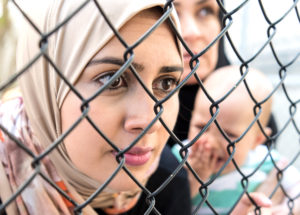
Person in hijab looking through a fence.
As a daughter of immigrant parents, I saw the various ways that life was about surviving so that their children’s lives could be about thriving.
My father was an asylum seeker from Eritrea, a small East African country bordering the Red Sea. He came to the United States in the 80s, escaping the country’s bloody independence war with Ethiopia. With no parents around him, he worked odd jobs to support himself through his engineering program.
My mother came to marry him shortly after graduating from medical school in Ethiopia. I grew up watching a smart, determined woman get denied over and over again from fulfilling her dream of being a doctor because her credentials wouldn’t transfer. That was the first time I realized my privilege of being a citizen.
My parents were actually really blessed compared to others in the Eritrean diaspora. Several of my uncles and cousins fought for Eritrea’s independence and were injured and still suffer from PTSD to this day.
I would listen to them lament the loss of their time and strength to a country that ended up turning into a dictatorship. They had to grow up fast, alone and far from home, but it was their hope that we would never have to experience what they went through.
As I came into my feminist consciousness, I became more and more aware of how immigration status is used to oppress people and marginalize immigrants of certain ethnic, socioeconomic and religious backgrounds.
My family constantly celebrates my American citizenship, my American education, and perfect American accent with pride, because they believe it allows me to overcome any obstacle and any form of discrimination they experienced.
Eritrea is now one of the top refugee producing countries as people leave the oppressive, poverty-stricken country.
My heart broke recently when I heard about a cousin who wanted to seek asylum in Italy. He boarded a boat heading towards the island of Lampedusa only to drown with hundreds of others in the Mediterranean Sea.
So, when I read about the global refugee crisis and the immigration debate, I don’t see numbers and statistics. I see real, breathing humans who look like my family. It is my duty to draw attention to a broken system that is pushing people to such extremes.
Here in the U.S., there are 11 million undocumented people. A large share of them have been living here for more than a decade. Since 2012, 800,000 of the 1.1 million eligible undocumented youth have been protected by DACA, while their parents aren’t guaranteed any path to citizenship.
And then there’s the global refugee crisis, which is getting devastatingly worse, while the Trump administration drafts policies to restrict immigrants, refugees, and asylum seekers and turn away people from Muslim-majority countries.
Now more than ever, people need to know what is at stake with immigration. We need to understand how the rise of xenophobia in the United States is pushing dangerous, inaccurate narratives that want to separate families and criminalize innocent people.
Let’s face it. The immigration process is scary, confusing and full of fine lines that are ever-changing.
But if you want to help family or community members navigate the process or simply push back against the idea that immigrants should just “wait in line,” here’s a simplified list of stipulations to the limited ways immigrants can come to the U.S.:
1. Do you have family members in the U.S.?
Family reunification is the number one way that people are able to immigrate to the U.S.
If you are an immediate relative of a U.S. citizen such as a minor child (under 18), spouse, parent or an adopted orphan, your entry is prioritized. Other relatives can seek family sponsorship if they are married or unmarried adult children, spouses and unmarried children of green card holders, and siblings.
Nearly 64% of immigrants come through the family reunification program, but it’s currently suffering from a major backlog. The wait time depends on when you filed, the country you are from, how many applicants came from that country, and the type of family relationship you have to the sponsor.
Consider this: If you are the brother or sister of a U.S. citizen from the Philippines, you would have been waiting since March 1, 1995 to be eligible for a green card in October 2017. That is some line to wait in!
You can check out the State Department’s Visa bulletin updated every month to find out how many immigrant visas are available each year.
2. Can you get employer sponsorship?
If you get a job offer in the U.S., your employer could potentially sponsor your green card which allows you to get permanent residence for a limited time. The employer has to be willing to petition for a visa for the employee and pay all the necessary fees through the process.
The U.S. Citizenship and Immigration services grant only 65,000 H-1B visas every year, which go to foreign workers with advanced degrees for up to three or six years of residence.
The other limited number of employer-sponsored visas go to temporary agricultural workers, seasonal agricultural workers and workers that have contributed to U.S. companies abroad.
What’s difficult about getting an employer-sponsored visa approved is that, with exception to the H1-B visa category, a company has to prove to the government that there were no qualified American citizens to fill that job.
Some companies may not have enough resources to cover the application costs, immigrant’s wages and other needs. This leaves out a large number of hardworking but lower-skilled immigrants with less formal education from getting sponsored.
What’s more, President Trump recently announced he wants the U.S. to move towards a merit-based immigration system that favors high-skilled, more educated immigrants over any other criteria.
3. Do you have “credible fear?”
If you are already in the U.S. and are afraid to go back to your home country, you can apply to be an asylum seeker.
To get legal protection as an asylee, you have to be able to prove in asylum court that you have credible fear for your life — that you could be persecuted, tortured or killed if you were to be sent back.
What an asylum officer accepts as credible fear and what evidence they request can make the approval process inconsistent, particularly when it comes to cases of domestic violence or gang violence.
If the officer dismisses a person’s case, they can request to be reviewed by an immigration judge. If the judge doesn’t find the asylum seeker to have a credible fear, then the person has to leave the country. You can get refugee status if you are still abroad but fleeing from persecution because of race, religion, nationality, membership in a particular social group, or political opinion.
Refugee status has to be officially recognized by the UN and the U.S. government overseas but it’s an incredibly slow system that is not meeting the needs of a dire global humanitarian crisis. The refugee admissions process can take from 18 to 24 months.
There are approximately 60 million refugees and displaced people in the world, according to the UNHCR. Most of them are stuck living in refugee camps or displaced in neighboring countries for years as less than one percent of refugees are resettled in countries like the U.S.
Last year, nearly half of the refugees admitted to the U.S. were from the Democratic Republic of Congo, Syria, and Burma. The number of refugees admitted yearly to the U.S. has been decreasing over time and the new administration now wants to cap it at the lowest number it’s ever been.
4. What country are you from?
In order to not let anyone nationality dominate the U.S. immigration flow, there is a cap on the number of immigrants allowed in from each country. One country cannot receive more than 7% of the total visas given out in a year.
There’s also a diversity lottery every year of 50,000 visas that are randomly distributed to immigrants from countries with historically low populations in the U.S. from Africa, Asia, Oceania, Central and South America.
Africa is actually the biggest region that has benefited from this lottery. The diversity visa is what brought 37% of African immigrants to the U.S. in 2015, coming from countries like Ethiopia, Sierra Leone, and Cameroon.
If you’re looking for asylum, you’re more likely to get it granted if you come from China or Guatemala. About 44% of asylum grants in 2015 came from China.
5. How old are you?
Children who were brought to the U.S. without documentation before they were 16 but had not reached 30 years of age are eligible for Deferred Action for Childhood Arrivals (DACA) program.
DACA was created by the Obama administration to give undocumented youth two-year relief from deportation, a permit to legally work in the U.S., go to college and more.
The majority of DACA recipients are originally from Mexico, are now employed and almost half are in school. There’s a stiff application fee of $465, which various organizations across the country like Mission Asset Fund and United We Dream have stepped up to help cover through fundraising.
The bad news is that Trump announced that he wants to end DACA, which means that DREAMers’ permits will expire in March 2018. The final deadline to renew DACA was on October 5, but the future for undocumented youth is up in the air unless Congress comes up with a solution.
6. Are you healthy?
If you don’t meet certain physical or mental health requirements, then you could be denied entry into the U.S.
Every immigrant seeking a visa must pass a medical examination that looks at any signs of violent or harmful behavior, if you’ve been treated for psychiatric or mental illness, or had any history of drug or alcohol addiction.
You also have to prove you have the required vaccinations for U.S. immigration such as influenza, polio and Hepatitis A and B and that you’ve been cleared of diseases like tuberculosis.
7. Can you support yourself financially?
We’ve all heard stories about immigrants who came with nothing but a few dollars in their pocket and a dream, but that’s not the reality anymore. Immigrants who can’t support themselves in the U.S. are simply not going to be let in.
You have to be able to prove that you can sufficiently provide for yourself or have a sponsor that will provide for you and a family because the government doesn’t want immigrants to end up using government assistance.
The U.S. government has specific poverty guidelines you have to meet in your application that are adjusted yearly based off of the size of your household and what state you live in. A family of 4 in Virginia, for example, would need to have a minimum income of $24,600 in 2017.
***
There’s a lot of uncertainty about what’s going to happen next with immigration reform in the country.
The Trump administration just announced an expansion of the travel ban and is actively trying to reduce the capacity of the refugee resettlement program, under the guise of saving money and protection from foreign threats.
Misconceptions about the immigration experience don’t just result in bad policymaking. It also creates a more hostile environment for immigrants who are able to get here.
For anyone who wants to be an immigrant ally, it’s important to have the facts at hand about how the system works to be able to defend immigrants when they are being disparaged or called ungrateful just for trying to speak up for their human rights in a broken system that too often ignores them.
For more information and helpful analysis on the U.S. immigration system and policies, check out the Migration Policy Institute or the American Immigration Council.
[do_widget id=’text-101′]
Nesima Aberra is an Everyday Feminism Reporting Fellow. Nesima is a writer and digital strategist passionate about social impact. She received her undergraduate degrees in Journalism and Global Studies from Arizona State University and her master’s degree in International Media from American University. In her free time, she enjoys reading, creative writing, traveling, and performing with The Sanctuaries and the Muslim Writers Collective. Follow her on Twitter: @NesimaAberra.
Search our 3000+ articles!
Read our articles about:
Our online racial justice training
Used by hundreds of universities, non-profits, and businesses.
Click to learn more




















